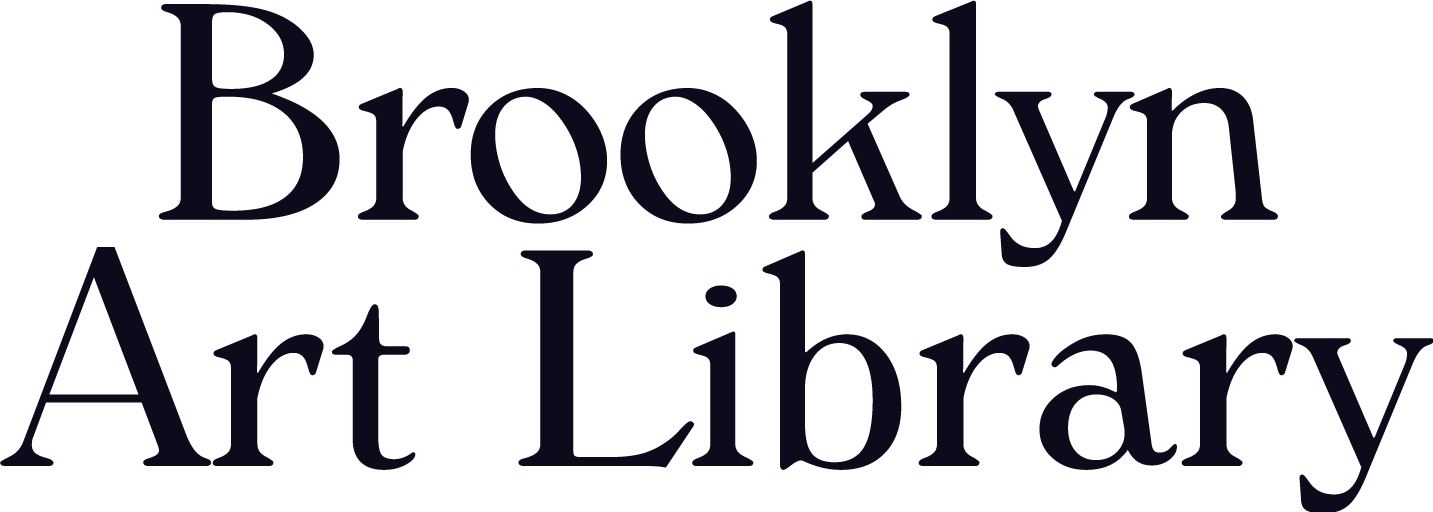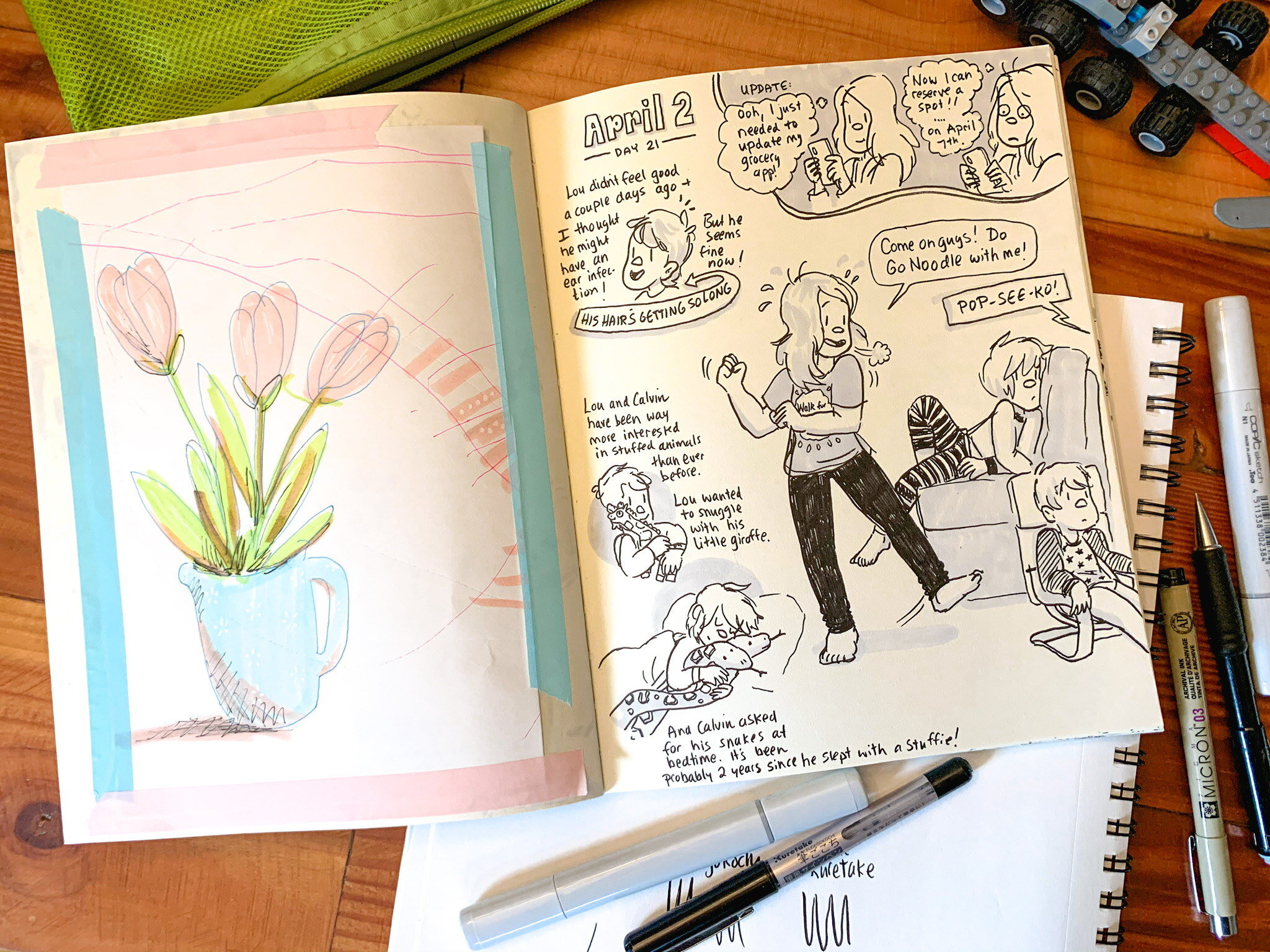Sketchbook Sunday with TOAF & BAL: Jill Quackenbush
Jill Quackenbush hails from Portland, Oregon, where she’s made a name for herself through her delightful comics about everyday life, incorporating whimsical bursts of colors and humorous storytelling through her digital and paper-based illustrations—not to mention her visual experience with web design and her growing portfolio of commissioned portraits. Always doodling or journaling her observations and travels, Jill’s sketchbooks offer insight into her process and the experiences that have inspired her. You can see her latest pieces on Instagram, visit her archive of comics on her website, and support her artwork through her Etsy shop.
Your 2013 sketchbook, “Sandy Blvd,” features bite-sized drawings of different sections of this long stretch of Portland roadway. Can you speak about not only the process of making the book, but what inspired you to create this visual catalog? Did it change the way you saw this street, and how you saw yourself in this urban space?
When I first moved to Portland in 2007, I wasn’t very fond of Sandy Blvd. It was obviously a street built for cars, lined with auto repair shops, parking lots, warehouses and dive bars. After I moved in with my boyfriend (now husband) who lived off of Sandy near Fremont, I commuted downtown on the bus via Sandy every weekday and I started to appreciate all the sights and signs and activity along the road.
My theme for the Sketchbook Project that year was “Atlas” so I decided to make a record of every building and sign along the section of the road I was most familiar with. I mainly used Google Street View as a reference but also drove around taking pictures of certain buildings and signs if the Street View images weren’t clear enough. I’m big on accuracy and attention to detail, but not big on having to come up with a new idea of what to draw everyday, so it was a great drawing exercise for me. Drawing every single block made me appreciate all the different styles of architecture, sign designs, and tucked away little buildings that I never really noticed before. Looking back at the sketchbook now, I feel nostalgic for all the businesses that are gone, and whole buildings that were torn down and replaced with condos since then! I just wish I had finished the south side of the road. Oh well! It’s still preserved for history on Street View.
What role do sketchbooks and journaling play in your daily art practice? Are you currently keeping a sketchbook?
I wish I could say I have a daily art practice, but I don’t! Even before I had kids, I would go long stretches (even years) without drawing at all. But I always come back to it and I feel better when I draw regularly. When I do draw, sketchbooks and journaling are my art practice! I kept a daily illustrated journal during my first pregnancy and I love looking back on it. I’m also a big fan of drawing challenges like the 100 Day Project or Inktober and when I do those I prefer to draw comics about my life or do a sketchbook journal. I’m currently attempting the 100 Day Project again with daily comic-style journal pages. I do miss free-form doodling and sketching and may try to start a regular daily doodle time with my kids (who would rather be building wooden train tracks or playing on my iPad). I’ve loved the Wendy MacNaughton #DrawTogether videos and might start watching them everyday myself even though my kids aren’t interested!
How did you get into art-making? Specifically, what drew you to cartoons and illustration?
I drew obsessively as a kid, and wrote and illustrated my own stories. I loved cartoons, and, in high school I started paying more attention to animation and character design styles, and watching the credits for which animation studios did which shows. I used to tape episodes of Ren & Stimpy so I could pause the episodes to study the poses and draw them myself.
I studied visual art in college and tried making what I thought was supposed to make: “fine art.” Printmaking, painting, still-life drawing, conceptual art, all that. My friends and my advisor suggested I focus more on the stuff I was doodling in the margins of my notes but it took me years to realize those doodles and cartoons weren’t just a way to pass the time, but could be a way to share ideas and experiences and connect with other people. After college, I was drawn to auto-bio comics and Moleskine travel sketchbook spreads that I saw online, so I started drawing some of my own and wanted to share them, but was very self-conscious about sharing things online. Participating in the Sketchbook Project was a way to push myself out of my comfort zone, knowing that I was drawing something with the intention of sharing it.
When I became a mom I started to post more of my “daily life” comics and drawings online and got so much positive feedback, like “I feel seen!” and “I’m glad I’m not alone” and that encouraged me to post more. I just love the feeling of connection that I get when I share an illustrated moment from my life that other parents can relate to. And I like making myself, and other people, laugh at the ridiculousness that is daily life with small children.
Can you describe your current workspace? How do your surroundings help you stay motivated (or get through creative blocks)?
For the last couple of years I’ve been slowly setting up a space in our finished attic with a desk, shelf space for art supplies, charger for my iPad and Apple Pencil, and an inspiration wall. But now that I am in charge of our kids full-time while my husband works from home in the attic, I mainly just draw at our dining table whenever I find the time. Or I draw while sitting in bed for the 2 minutes before I fall asleep, or leaning against the kitchen counter when I’m hiding—uh, I mean, taking a break—from my kids. I have a canvas bag (that my mom made!) that I tote around with my sketchbooks, pouch with my pens and Copic markers, a book that maybe I’ll read someday, etc.
I’m still working on how to stay motivated. I actually feel the most motivated when I’m interacting with people online (or in the old days, in person) talking about a comic I posted or a parenting struggle I wrote about. I’ve always meant to create a kind of “sacred” art space that was only meant for drawing and journaling and experimenting, where phones and laptops and other distractions would be banned, but I haven’t done it yet. Right now my old desk is a fabric cutting and ironing station for sewing masks.
Along with commissioned portraits and observational doodles from your travels, you also make comics. How do you begin planning out these multi-panel spreads?
I think a lot about ideas for comics in the shower, or I will make a little note on my phone of something funny one of the kids said, or a thought I had about parenting. I’ve done some four-panel comics on my iPad and that has worked well to have that constraint, and a template that I can copy and paste. So far, I’ve been doing most of the comic-planning in my head as I’m doing other things throughout the day. Sometimes, something just won’t work out as I’m drawing it and I’ll have to sketch and try a few things as I go. I’m a recovering perfectionist so for the last couple of years I’ve forced myself to try drawing directly with ink on paper without sketching, although I do still try and plan a rough layout in my head. Sometimes the results are not what I wanted, but I appreciate how quickly I can get the information down and then share it. As long as it is readable, I go with it. If I really like the comic, I’ll redo it later with a better plan, but I have yet to do that.
Who or where do you go to look for inspiration?
Of course, my own kids and family are a big inspiration. It’s taken me a while to recognize that the time with my kids is all part of my creative process (along with quiet time to digest and formulate ideas, which sometimes only happens in the shower). Some days I feel resentful that I don’t have more time to draw and make art, but thinking of my plentiful family time as critical to my creative process has helped me shift my attitude a bit.
For outside inspiration, I often look at auto-bio comics on my bookshelf or online! Lucy Knisley has been a fav for a long time and I’ve loved seeing her comics on Patreon and Instagram about becoming a mom and parenting. Sometimes a conversation (in person or via text) with another mom will spark an idea. I love watching YouTube channels of artists who share their daily lives and struggles and processes, although I have to be careful or I will get sucked in, watching videos all day. Fran Meneses is by far my favorite and an inspiration for being so open and honest about her creative process and setbacks and wins, and just for being a nice human. The Creative Pep Talk podcast has also been a huge inspiration and motivator for me for the last couple of years.
How have present circumstances impacted your creativity? Do you have any advice for those struggling to make art right now?
I’ve had to scale back some of my bigger money-making illustration plans and focus more on the basics of what I enjoy and what I can get done quickly with the limited windows of time I have while watching my kids. At the beginning of our “quarantine”, I didn’t draw anything or journal at all. But after the first few weeks, as we started settling into the new normal, I felt the desire to record what was happening in the world and at our house, and to share it online. It was my way of commiserating with all the other parents who were experiencing the cycle of “I’m so grateful my family is healthy, and I’m glad I have my kids as a distraction” to “I’m a complete failure as a parent” to “if you need me I’ll be sitting on the bathroom floor with earplugs in, drinking a beer and eating a whole bag of Fritos”.
I’m big on drawing or painting in a meditative way when I feel stuck or lost or stressed. I really enjoyed doing Lisa Solomon’s color meditation class on Creative Bug. Draw one shape over and over in different colors with just whatever color speaks to you, even ones that don’t ‘go together.’ Do one of Lynda Barry’s spirals. Draw something from memory with your eyes closed (another idea I got from Lynda Barry). Or draw a blind line-contour self-portrait like Austin Kleon. Draw as many cartoon characters as you can think of from memory as fast as you can (this one’s from Ivan Brunetti’s book Cartooning which has all kinds of fun drawing exercises). Watch a drawing video or class aimed at kids (I recommend Wendy MacNaughton!). Pick a favorite comic book and copy one of the panels. I love low-stakes, low-stress drawing exercises that get me out of my head, especially ones that feel a bit silly.


